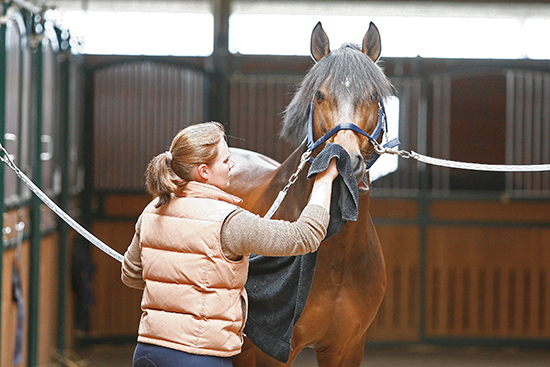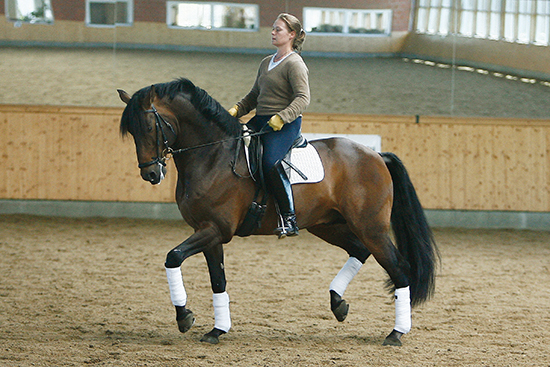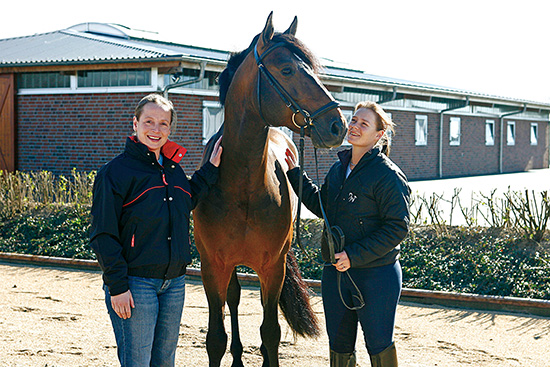 Story by Chris Hector and Photos by Karl-Heinz Frieler
Story by Chris Hector and Photos by Karl-Heinz Frieler
Hayley Beresford was one of Australia’s most exciting young dressage talents, and I guess it is no surprise to see her making her mark on the world’s toughest dressage circuit – in Germany. But how on earth did Hayley make it from Australia to Germany to working with World and Olympic champion, Isabell Werth?
“Isabell came to the Master Class at Dressage with the Stars in 2000. I rode in that with Galactic, and we talked about it then. But at that stage I was 21, I didn’t really believe I could come to Germany and be good enough. A lot of Australians come to Germany and are swallowed up. I didn’t just want to be cleaning stables in Europe.”
“Then I was back in Perth, and Isabell came back in 2005. I’d just sold Galactic, but had kept the ride for the clinic. I thought it would be a nice way to finish my partnership with him. He was really working well, Inter 1, Inter 2, and we were talking about it again. I said, ‘I’ve sold him now, and I’m not really sure’… Two weeks later, Isabell sent me an email, inviting me to come and stay.”
“I was quite fortunate in that clinic. I was riding a young stallion as well, a very talented stallion, but quite testing – I thought it was good for her to see me riding Galactic, and then a spirited young horse.”
“I went to Germany and I was quite undecided about living here. I’d had cancer for two years, and was still in remission… So I was backwards and forwards a bit. The first time I came was for six weeks, then I was home. I was only home for three weeks before I was pretty itchy to get back. When I came back we talked about it, and Isabell said I was welcome to stay. I went home, sold my house, sold my car, sold everything, wound up my business and started full time in Germany in November 2006.”
“There were a lot of adjustments for me to make with my riding. It was easier for me than a lot of riders because Isabell and I are the same body type. I have the same principles with the horses – it has to be done through relaxation as the first priority. This was all similar, but with some horses you can apply that way of riding and it works – but then along would come a difficult horse, and I was really needing her help. I have learnt so much in such a short time.”
“Last year was a bit easier because I was just competing in the Small Tour. This year I started to do my first Grand Prix with Retiro – this has been a big learning curve to say the least!”
“My horse, Relampago do Retiro, arrived at the stables just before I did, a few weeks before I arrived. They were trying to prepare him for the Pan American Games with a Brazilian rider. He’s quite sensitive, and it wasn’t really working – but from day one we really worked. It’s just gone step by step from there. When it wasn’t going to work for the Pan American Games, I took over competing with him. My first show was last year at Hagen. He was quite sensitive but we learnt a lot about each other. He developed in a super quick way. He’s very intelligent, and a very forgiving horse. We’ve learnt together.”
“He is from Brazil, from the breeder Eduardo Fischer of the stud Villa do Retiro, where they breed a lot of Lusitano horses. The ride on him is very safe with me. He’s to be ridden for Australia – and it is a long term ride…”
Was it hard to be accepted – an Australian riding a Brazilian horse in Germany?
“At the beginning it was, and we both suffered a bit. I’m just a little Australian riding a little Brazilian horse, who are we to be here? But you chip away at it. I had a big break through at Balve last year because we did a very good test. I think since then the judges have talked about him a fair bit. We don’t present him as a Spanish or Portuguese horse, we prepare him and train him, and we’ve developed him, in our system. He works like all our other Warmblood horses. He’s really through the neck and over the back. Last year they were saying, oh he looks like a little Rubinstein. It’s like any rider, you have to become acknowledged and get a bit of respect, it’s like any sport.”
What does a typical day look like for you?
“I’m on the internet very early to check emails. I’m at the stables at 7, to make my first horse ready. I ride til about 2.30 – between eight and ten horses. Then I start teaching at 3.”
In what language, Deutsch?
“My own special language. It’s mostly Deutsch but with English joining words. It’s quite funny if someone from Germany comes in and starts listening, but the students take English at school and they seem to understand.”
Do you find you fit into Germany?
“Yeah, I must admit I’ve been helped because the family Werth are sensational. They look after the whole team like we are their kids. Where I am living I have been kind of adopted by a family and they have three children, and they are really supportive, they look after me when I stop looking after myself. They feed me quite often. Like everyone, I’ve had moments when I am homesick but I’m completely addicted to the competition. It is a long way from home and all the usual support – I’d like to thank Pete and Caro of Wagners Saddlery who helped me out with competition clothes – one thing for sure Wagners clothes look great anywhere in the world.”
“I’m enjoying it, and now summer is here, it is easier. The winter is long, it is not so much the cold, it’s that the days are so short and the sky doesn’t turn blue, but it is not so bad, especially now when you can see the results…”



